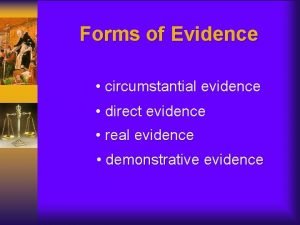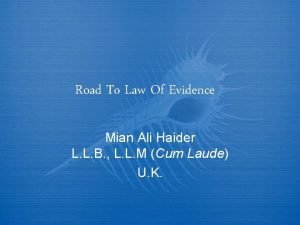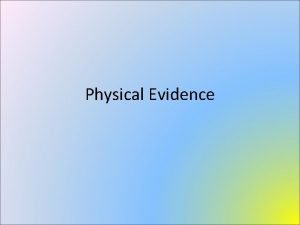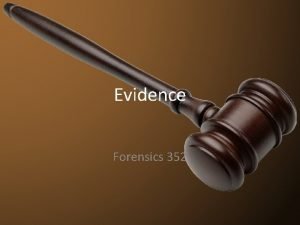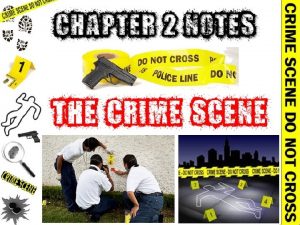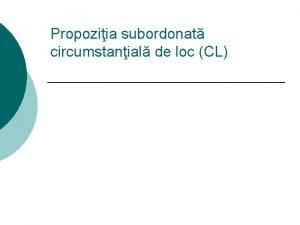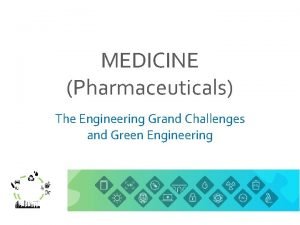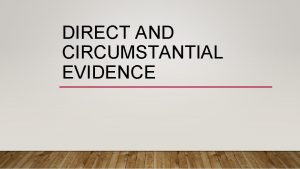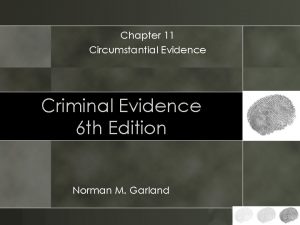Forms of Evidence circumstantial evidence direct evidence real





![Evidentiary Tendency Inculpate: [verb] to incriminate Inculpatory Evidence: Evidence that would tend to incriminate Evidentiary Tendency Inculpate: [verb] to incriminate Inculpatory Evidence: Evidence that would tend to incriminate](https://slidetodoc.com/presentation_image_h/f4387a9d57ce52e87e3a2e0ecd642cbb/image-6.jpg)

- Slides: 7

Forms of Evidence • circumstantial evidence • direct evidence • real evidence • demonstrative evidence

Circumstantial Evidence: A form of evidence that allows a judge or jury to infer or accept a fact based on a set of known circumstances. A fact that can be used to infer another fact. Example: The cookie monster is found standing by an open cookie jar with cookie crumbs on his face. The circumstantial evidence would indicate that the cookie monster ate a cookie. However, he was not actually seen eating the cookie. Acid Test: You can believe the evidence without necessarily concluding that the accused is guilty. There are other possible inferences that could be made.

Direct Evidence: An eyewitness has seen or heard the alleged events, or some real evidence is provided which proves a fact in question. (The fact in question must prove the guilt of the accused. ) Example: Someone sees cookie monster eat a cookie out of the cookie jar. COOKIES Acid Test: If you believe the evidence (ie. eye-witness testimony), then you are forced to conclude that the accused is guilty. There are no other inferences that can be made.

Real Evidence (physical): evidence that consists of physical objects that can be offered into evidence. Example: The cookie jar with the cookie monster’s fingerprints on it. Other typical examples… weapons, tool markings, fingerprints, blood, hair, skin samples Acid Test: Can the item be labeled and deposited with the court?

Demonstrative evidence: Evidence that is prepared by an attorney in an effort to assist the trier of fact in visualizing or comprehending other evidence. Example: A map of the kitchen showing the cookie monster’s proximity and access to the cookie jar. Other typical examples… charts, maps, photographs, crime sketches Acid Test: Does the item itself actually prove the fact, or does it demonstrate a fact that must be proven using some other form of evidence? (Such as an eye witness or an expert witness. )
![Evidentiary Tendency Inculpate verb to incriminate Inculpatory Evidence Evidence that would tend to incriminate Evidentiary Tendency Inculpate: [verb] to incriminate Inculpatory Evidence: Evidence that would tend to incriminate](https://slidetodoc.com/presentation_image_h/f4387a9d57ce52e87e3a2e0ecd642cbb/image-6.jpg)
Evidentiary Tendency Inculpate: [verb] to incriminate Inculpatory Evidence: Evidence that would tend to incriminate the accused. Exculpate: [verb] to exonerate, vindicate, redeem Exculpatory Evidence: Evidence that would tend to exonerate the accused.

Myths Regarding Evidence Myth #1: You can’t convict someone on circumstantial evidence alone. As there is often no witness to the crime, many convictions are based solely on circumstantial evidence. The probable conclusions based on circumstantial evidence can be very strong. There is no legal distinction between direct and circumstantial evidence as far as probative value - it is up to the trier of fact to decide how much weight to give to any particular evidence. Myth #2: Direct evidence (from an eyewitness) is more reliable than circumstantial evidence. Many studies have indicated that an eyewitness’ recollection of events is often quite inaccurate. Eyewitnesses often make positive t… c fa e th n o ti mennegative errors (forgetting correct Not toand errors (adding false details), details). Memory seems to be. Einfluenced P OPLE LIE!!! by a witness’ expectations, beliefs, age, stress level, as well as the manner in which questions are posed to the witness.

